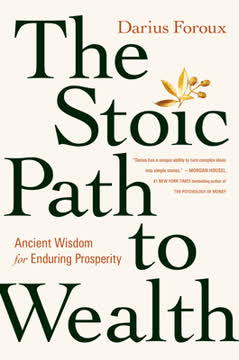Key Takeaways
1. Authentic leadership emerges from life experiences, not universal traits
Analyzing 3,000 pages of transcripts, our team was startled to see that these people did not identify any universal characteristics, traits, skills, or styles that led to their success. Rather, their leadership emerged from their life stories.
Life shapes leadership. Authentic leaders draw inspiration and lessons from their personal experiences, both positive and negative. They constantly test themselves through real-world challenges, reframing their life stories to understand their core purpose. This process of self-discovery allows leaders to develop a unique leadership style that feels genuine and aligns with their values.
Transformative experiences. Many leaders report that their motivation came from difficult life events, such as:
- Loss of a job
- Personal illness
- Death of a close friend or relative
- Feelings of exclusion or discrimination
Instead of seeing themselves as victims, authentic leaders use these formative experiences to give meaning to their lives and discover their passion for leading. They reframe challenges as opportunities for growth and self-discovery, ultimately shaping their leadership approach.
2. Self-awareness is crucial for developing authentic leadership
When the 75 members of Stanford Graduate School of Business's Advisory Council were asked to recommend the most important capability for leaders to develop, their answer was nearly unanimous: self-awareness.
Know thyself. Self-awareness is the foundation of authentic leadership. It requires courage and honesty to examine one's experiences, strengths, weaknesses, and values. Leaders must be willing to confront their blind spots and listen to feedback, especially the kind they don't want to hear.
Developing self-awareness involves:
- Reflecting on past experiences and their impact
- Seeking honest feedback from others
- Identifying personal values and motivations
- Recognizing patterns in behavior and decision-making
- Embracing vulnerability and admitting mistakes
As leaders become more self-aware, they become more humane and willing to be vulnerable. This authenticity allows them to connect more deeply with their teams and make decisions that align with their true selves.
3. Practicing values consistently builds leadership principles
Leadership principles are values translated into action. Having a solid base of values and testing them under fire enables you to develop the principles you will use in leading.
Values in action. Authentic leaders don't just talk about their values; they consistently practice them, especially under pressure. When faced with difficult decisions, they rely on their core beliefs to guide their actions. This consistency builds trust and credibility with their teams.
Developing leadership principles:
- Identify core personal values
- Translate values into actionable principles
- Test principles in challenging situations
- Refine and adjust based on real-world experiences
- Communicate principles clearly to others
By living their values, leaders demonstrate integrity and inspire others to do the same. This approach creates a strong ethical foundation for the entire organization and helps navigate complex decisions with clarity and purpose.
4. Balance extrinsic and intrinsic motivations for sustained leadership
The key is to find a balance between your desires for external validation and the intrinsic motivations that provide fulfillment in your work.
Motivation matters. Authentic leaders understand the importance of balancing external rewards (such as recognition and financial success) with internal drivers (like personal growth and making a difference). This balance helps maintain high levels of motivation and prevents burnout.
Balancing motivations:
- Extrinsic: Recognition, status, financial rewards
- Intrinsic: Personal growth, helping others, social impact
Leaders should be aware of their motivations and regularly reassess them. As careers progress, the balance may shift towards intrinsic factors. Recognizing and nurturing these deeper motivations can lead to more fulfilling and sustainable leadership over time.
5. Build a diverse support team to maintain authenticity
Authentic leaders build extraordinary support teams to help them stay on course. Those teams counsel them in times of uncertainty, help them in times of difficulty, and celebrate with them in times of success.
You can't go it alone. Even the most confident leaders need support and perspective from others. A diverse support network helps leaders stay grounded, provides honest feedback, and offers different viewpoints. This team should include both personal and professional connections.
Components of a support team:
- Spouse or significant other
- Family members
- Mentors
- Close friends
- Trusted colleagues
Building a support team requires giving as much as receiving. Leaders must invest time and energy in these relationships, creating mutual trust and understanding. This network becomes crucial during challenging times, providing a safe space for vulnerability and growth.
6. Integrate work and personal life to stay grounded as a leader
Integrating their lives is one of the greatest challenges leaders face. To lead a balanced life, you need to bring together all of its constituent elements—work, family, community, and friends—so that you can be the same person in each environment.
Holistic leadership. Authentic leaders strive to integrate all aspects of their lives, rather than compartmentalizing. This integration allows them to be consistent and genuine across all contexts, reducing stress and increasing overall fulfillment.
Strategies for integration:
- Align personal and professional values
- Set boundaries to protect personal time
- Engage in activities outside of work
- Bring your whole self to each environment
- Practice self-care and stress management
By integrating their lives, leaders can draw strength and inspiration from all areas, enhancing their effectiveness and authenticity in the workplace. This approach also sets an example for others, promoting a healthier work-life balance throughout the organization.
7. Empower others to lead for long-term organizational success
Authentic leaders recognize that leadership is not about their success or about getting loyal subordinates to follow them. They know the key to a successful organization is having empowered leaders at all levels, including those who have no direct reports.
Cultivate leadership. True leaders focus on developing and empowering others rather than hoarding power. By creating a culture of leadership throughout the organization, they ensure long-term success and sustainability.
Ways to empower others:
- Delegate meaningful responsibilities
- Provide opportunities for growth and learning
- Offer constructive feedback and mentorship
- Recognize and celebrate others' achievements
- Create an environment that encourages initiative
Empowering others not only develops a stronger organization but also allows authentic leaders to focus on higher-level strategic thinking and innovation. This approach creates a virtuous cycle of leadership development and organizational success.
8. Embrace vulnerability to foster genuine connections
Vulnerability here does not mean being weak or submissive. To the contrary, it implies the courage to be oneself. It means replacing "professional distance and cool" with uncertainty, risk, and emotional exposure.
Courage to connect. Authentic leaders understand that vulnerability is a strength, not a weakness. By showing their human side, they create deeper connections with their team and build trust. This openness encourages others to be more authentic and engaged.
Benefits of embracing vulnerability:
- Builds trust and rapport
- Encourages open communication
- Fosters a culture of learning from mistakes
- Promotes creativity and innovation
- Enhances emotional intelligence
Leaders who embrace vulnerability create psychologically safe environments where team members feel comfortable taking risks and sharing ideas. This leads to increased collaboration, problem-solving, and overall organizational performance.
9. Adapt leadership style while maintaining core authenticity
Your leadership identity can and should change each time you move on to bigger and better things.
Evolve authentically. Authentic leadership is not about rigidly adhering to a fixed set of behaviors. Instead, it involves adapting one's style to new challenges and contexts while remaining true to core values and principles.
Steps for authentic adaptation:
- Identify core values and principles
- Assess new leadership challenges
- Experiment with different approaches
- Seek feedback and reflect on experiences
- Integrate successful adaptations into leadership style
By viewing leadership as a journey of growth and learning, authentic leaders can continually refine their approach without compromising their integrity. This flexibility allows them to remain effective in diverse situations and as they advance in their careers.
10. Express appropriate emotions to enhance leadership effectiveness
When the CEO appeared sad, participants rated him as more sincere and were more likely to want to reconcile with him.
Emotional intelligence matters. Authentic leaders understand the power of appropriate emotional expression. They recognize that showing genuine emotions can enhance their credibility and connection with others, particularly in challenging situations.
Guidelines for emotional expression:
- Match emotions to the situation
- Show empathy and understanding
- Be genuine, not performative
- Use emotions to reinforce messages
- Balance vulnerability with strength
Expressing appropriate emotions helps leaders humanize themselves and demonstrate that they care about their team and the organization's mission. However, it's crucial to maintain a balance, ensuring that emotional displays don't undermine leadership authority or create discomfort among team members.
Last updated:
FAQ
1. What is "Authentic Leadership" by Harvard Business Review about?
- Explores the concept of authentic leadership, emphasizing the importance of self-awareness, values, and genuine behavior in effective leadership.
- Draws on research, interviews, and real-world examples to show how leaders can develop authenticity and empower others.
- Covers challenges such as vulnerability, emotional expression, and the paradoxes of being authentic in diverse and changing environments.
- Includes essays and research from multiple experts, offering a comprehensive look at authenticity in leadership across cultures and contexts.
2. Why should I read "Authentic Leadership" by Harvard Business Review?
- Provides actionable insights for anyone seeking to lead with integrity and impact, regardless of their position or industry.
- Offers practical advice and real-life stories from CEOs and leaders who have navigated the journey to authentic leadership.
- Addresses current workplace challenges like trust deficits, diversity, and emotional intelligence, making it highly relevant for today’s leaders.
- Helps readers understand the value of self-awareness, vulnerability, and balancing personal and professional identities.
3. What are the key takeaways from "Authentic Leadership" by Harvard Business Review?
- Authentic leadership is rooted in self-awareness, personal values, and life stories, not in imitating others or following a set formula.
- Leaders must balance intrinsic and extrinsic motivations, practice their values under pressure, and build strong support teams.
- Vulnerability, emotional intelligence, and tough empathy are essential for building trust and connection with teams.
- Authenticity is complex and sometimes paradoxical; leaders must adapt, learn from diverse role models, and evolve their leadership identity over time.
4. How does "Authentic Leadership" by Harvard Business Review define authentic leadership?
- Authentic leadership is leading with a deep sense of self-awareness, acting consistently with one’s core values and principles.
- It involves being genuine, transparent, and true to oneself, rather than imitating others or conforming to external expectations.
- Authentic leaders empower others, build meaningful relationships, and integrate their personal and professional lives.
- The book emphasizes that authenticity is developed through life experiences, reflection, and ongoing personal growth.
5. What practical steps does "Authentic Leadership" by Harvard Business Review recommend for becoming an authentic leader?
- Reflect on and reframe your life story to understand your motivations, values, and purpose.
- Seek honest feedback to increase self-awareness and identify blind spots, even when it’s uncomfortable.
- Practice your values and principles, especially when they are tested under pressure or risk.
- Build a diverse support team of mentors, friends, and colleagues who provide honest feedback and encouragement.
6. How does "Authentic Leadership" by Harvard Business Review address the role of vulnerability in leadership?
- Vulnerability is presented as a strength, not a weakness, enabling leaders to build trust and deeper connections with their teams.
- Sharing doubts, admitting mistakes, and showing genuine emotion fosters loyalty and engagement among employees.
- The book cites research showing that authenticity and vulnerability are at the root of human connection and effective leadership.
- Leaders who embrace vulnerability are more likely to receive valuable feedback and support, reducing isolation at the top.
7. What is the "authenticity paradox" discussed in "Authentic Leadership" by Harvard Business Review?
- The authenticity paradox refers to the tension between staying true to oneself and adapting to new roles or environments.
- Leaders may feel like impostors when stepping outside their comfort zones, but growth often requires experimenting with new behaviors.
- The book argues that authenticity is not static; leaders must evolve their identities and sometimes feel "inauthentic" as they learn.
- Emphasizes the importance of learning from diverse role models and being open to change, rather than rigidly clinging to a fixed self-concept.
8. How does "Authentic Leadership" by Harvard Business Review suggest leaders balance intrinsic and extrinsic motivations?
- Leaders are encouraged to understand both their internal drives (purpose, growth, helping others) and external rewards (status, money).
- The book warns against being overly driven by external validation, which can lead to burnout or loss of fulfillment.
- Finding alignment between intrinsic motivations and daily work leads to greater satisfaction and sustainable success.
- Leaders should regularly reflect on what truly brings them happiness and fulfillment, adjusting their goals accordingly.
9. What is the importance of self-awareness in "Authentic Leadership" by Harvard Business Review, and how can it be developed?
- Self-awareness is identified as the most critical capability for leaders, forming the foundation of authenticity.
- It involves honest self-examination, recognizing strengths, weaknesses, and the impact of one’s behavior on others.
- The book recommends seeking feedback, engaging in reflection, and being open to learning from failures and setbacks.
- Developing self-awareness is a lifelong process, requiring courage, humility, and a willingness to confront uncomfortable truths.
10. How does "Authentic Leadership" by Harvard Business Review address diversity, inclusion, and the challenges faced by people of color?
- The book highlights that traditional standards of "executive presence" often reflect white male norms, making it harder for professionals of color to be seen as leaders without sacrificing authenticity.
- It discusses the lack of feedback and sponsorship for people of color, which can hinder their advancement and sense of belonging.
- Authenticity for diverse leaders may require navigating cultural expectations and finding ways to lead effectively without losing their identity.
- The book calls for organizations to recognize and value diverse leadership styles, fostering environments where all leaders can be authentic.
11. What are some key concepts like "tough empathy," "outsight," and "work-life integration" in "Authentic Leadership" by Harvard Business Review?
- Tough empathy: Leading with both care and high expectations, giving people what they need (not just what they want) while maintaining respect for individuals and the task.
- Outsight: Gaining external perspective by experimenting with new behaviors, learning from others, and acting before introspecting, especially during transitions.
- Work-life integration: Striving to be the same person across work, family, and community, breaking down barriers between different aspects of life to maintain authenticity and balance.
- These concepts help leaders navigate the complexities of authenticity, growth, and connection in modern organizations.
12. What are the best quotes from "Authentic Leadership" by Harvard Business Review and what do they mean?
- “No one can be authentic by trying to imitate someone else.” — Emphasizes the importance of self-discovery over imitation in leadership.
- “The story of your life is not your life. It is your story.” — Highlights the power of personal narrative and reframing experiences to find purpose.
- “Tough empathy means giving people what they need, not what they want.” — Underlines the balance between compassion and accountability in leadership.
- “The only way we grow as leaders is by stretching the limits of who we are—doing new things that make us uncomfortable but that teach us through direct experience who we want to become.” — Encourages leaders to embrace discomfort and experimentation as paths to authentic growth.
Review Summary
Authentic Leadership by Harvard Business Review receives mixed reviews. Readers appreciate its diverse perspectives on leadership authenticity, emotional intelligence, and workplace dynamics. Some find it thought-provoking and practical, while others criticize it for being basic or contradictory. The book's strengths include real-life examples, research-based insights, and discussions on balancing authenticity with adaptability. Critics argue it lacks depth or offers conflicting advice. Overall, readers value its concise format and potential for self-reflection, though opinions vary on its effectiveness in providing actionable leadership guidance.
Similar Books










Download PDF
Download EPUB
.epub digital book format is ideal for reading ebooks on phones, tablets, and e-readers.














